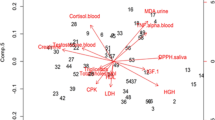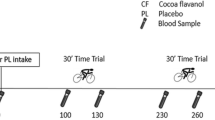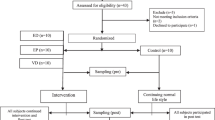Abstract
The purpose of this randomized study was to measure the influence of 6 weeks of LCPUFA (600 mg EPA and 400 mg DHA per day) supplementation alone or in association with 30 mg vitamin E, 60 mg vitamin C and 6 mg β-carotene on resting and exercise-induced lipid peroxidation in judoists (n = 36). Blood samples were collected at rest before (T 1) and after the supplementation period, in preexercise (T 2) and postexercise (T 3) conditions, for analysis of α-tocopherol, retinol, lag phase (Lp) before free radical-induced oxidation, maximum rate of oxidation (R max) during the propagating chain reaction, maximum amount of conjugated dienes (CDmax) accumulated after the propagation phase, and nitric oxide, malondialdehyde and lipoperoxide (POOL) concentrations. Dietary data were collected using a 7-day diet record. There were no significant differences among treatment groups with respect to habitual intakes of energy from fat, carbohydrate, or protein. At T 1, there were no significant differences among treatment groups with respect to lipid peroxidation, lag phase, and levels of α-tocopherol or retinol. The consumption of an n-3 LC PUFA supplement increased oxidative stress at rest and did not attenuate the exercise-induced oxidative stress. The addition of antioxidants did not prevent the formation of oxidation products at rest. On the contrary, it seems that the combination of antioxidants added to the n-3 LCPUFA supplement led to a decrease in, CDmax, R max, and POOL and MDA concentrations after a judo training session.


Similar content being viewed by others
References
Agarwal R, Chase SD (2002) Rapid, fluorimetric-liquid chromatographic determination of malondialdehyde in biological samples. J Chromatogr 775:121–126
Allard J, Kurian R, Aghdassi E, Muggli R, Royall D (1997) Lipid peroxidation during n-3 fatty acid and vitamin E supplementation in humans. Lipids 32:535–541
Altan O, Pabuccuoglu A, Altan A, Konyalioglu S, Bayraktar H (2003) Effect of heat stress on oxidative stress, lipid peroxidation and some stress parameters in broilers. Br Poult Sci 44:545–550
Andrade PMM, Ribeiro BG, Bozza MT, Costa Rosa LFB, Tavares do Carmo MG (2007) Effects of the fish-oil supplementation on the immune and inflammatory responses in elite swimmers. Prost Leukot Essent Fat Acids 77:139–145
Armstrong RB, Ogilvie RW, Schwane JA (1983) Eccentric exercise-induced injury to rat skeletal muscle. J Appl Physiol 54:80–93
Bauchart D, Gobert M, Habeanu M, Parafita E, Gruffat D, Durand D (2010) Influence des acides gras polyinsaturés n-3 et des antioxydants alimentaires sur les acides gras de la viande et la lipoperoxydation chez le bovin en finition. Oléagineux, Corps gras, Lipides 17:30–36
Bloomer RJ, Goldfarb AH (2004) Anaerobic exercise and oxidative stress: a review. Can J Appl Physiol 29:245–263
Bloomer RJ, Goldfarb AH, McKenzie MJ (2006) Oxidative stress response to aerobic exercise: comparison of antioxidant supplements. Med Sci Sports Exerc 38:1098–1105
Bloomer RJ, Larson DE, Fisher-Wellman KH, Galpin AJ, Schilling BK (2009) Effect of eicosapentaenoic and docosahexaenoic acid on resting and exercise-induced inflammatory and oxidative stress biomarkers: a randomized, placebo controlled, cross-over study. Lipids Health Dis 19:8–36
Bryan NS, Grisham MB (2007) Methods to detect nitric oxide and its metabolites in biological samples. Free Rad Biol Med 43:645–657
Cholewa J, Poprzecki S, Zajac A, Waskiewicz Z (2008) The influence of vitamin C on blood oxidative stress parameters in basketball players in response to maximal exercise. Sci Sports 23:176–182
Clarkson PM, Thompson HS (2000) Antioxidants: what role do they play in physical activity and health? Am J Clin Nutr 72:637S–646S
Cohen J (1988) Statistical analysis for the behavioural sciences. Lawrence Erlbaum, Hillsdale
Davison G, Gleeson M, Phillips S (2007) Antioxidant supplementation and immunoendocrine responses to prolonged exercise. Med Sci Sports Exerc 39:645–652
Degoutte F, Jouanel P, Filaire E (2003) Energy demands during a judo match and recovery. Br J Sports Med 37:245–249
Diplock AT, Rice-Evans AC, Burton RH (1994) Is there a significant role for lipid peroxidation in the causation of malignancy and for antioxidants in cancer prevention? Cancer Res 54:19525–19526
Durnin JVGA, Rahaman MM (1967) The assessment of the amount of fat in the human body from measurement of skinfold thickness. Br J Nutr 21:681–689
Esterbauer H, Striegl G, Puhl H, Rotheneder M (1989) Continuous monitoring of in vitro oxidation of human low density lipoprotein. Free Rad Res Comm 6:67–75
Finaud J, Degoutte F, Scislowski V, Rouveix M, Durand D, Filaire E (2006) Competition and food restriction effects on oxidative stress in judo. Int J Sports Med 27:834–841
Fisher-Wellman K, Bloomer RJ (2009) Acute exercise and oxidative stress: a 30 year history. Dyn Med 13:1–25
Gladine C, Morand C, Rock E, Bauchart D, Durand D (2007) Plantation extracts rich in polyphenols are efficient antioxidants to prevent lipoperoxidation in plasma lipids from animals fed PUFA n-3 supplemented diets. Anim Feed Sci Technol 136:281–296
Gobert M, Martin B, Ferlay A, Chilliard Y, Graulet B, Pradel P, Bauchart D, Durand D (2009) Plant polyphenols associated with vitamin E can reduce plasma lipoperoxidation in dairy cows given n-3 polyunsaturated fatty acids. J Dairy Sci 92:6095–6104
Goldfarb AH, Bloomer RJ, McKenzie MJ (2005) Combined antioxidant treatment effects on blood oxidative stress after eccentric exercise. Med Sci Sports Exerc 37:234–239
Gomez-Cabrera MC, Domenech E, Vina J (2008) Moderate exercise is an antioxidant: upregulation of antioxidant genes by training. Free Rad Biol Med 44:126–131
Groussard R-B, Machefer C, Vincent S, Cillard G-D (2003) Changes in blood lipid peroxidation markers and antioxidants after a single sprint anaerobic exercise. Eur J Appl Physiol 89:14–20
Guichardant M, Bacot S, Moliere P, Lagarde M (2006) Hydroxy-alkenals from the peroxidation of n-3 and n-6 fatty acids and urinary metabolites. Prostaglandins Leukot Essent Fatty Acids 75:179–182
Gutierrez J, Ballinger S, Darley-Usmar VM, Landar A (2006) Free radicals, mitochondria, and oxidized lipids, the emerging role in signal transduction in vascular cells. Circ Res 99:924–932
Hale T, Armstrong N, Hardman A, Jakeman P, Sharp C, Winter E (1988) Position statement on the physiological assessment of the elite competitor, 2nd edn. British Association of Sports Sciences, Leeds
Hildebrandt W, Alexander S, Bartsch P, Droge W (2002) Effect of N-acetyl-cysteine on the hypoxic ventilatory response and erythropoietin production: linkage between plasma thiol redox state and O2 chemosensitivity. Blood 99:1552–1555
Ihara H, Shino Y, Morita Y, Kawaguchi E, Hashizume N, Yoshida M (2001) Is skeletal muscle damaged by the oxidative stress following anaerobic exercise? J Clin Lab Anal 15:239–243
Jackson MJ (1999) Free radicals in skin and muscle: damaging agents or signals for adaptation? Proc Nutr Soc 58:673–676
Ji Q, Zhang L, Jia H, Xu J (2004) Pentoxifylline inhibits endotoxin-induced NF-kappa B activation and associated production of proinflammatory cytokines. Ann Clin Lab Sci 34:427–436
Karvonen J, Vuorimaa T (1988) Heart rate and exercise intensity during sport activities. Practical application. Sports Med 5:303–312
Keong CC, Singh HJ, Singh R (2006) Effects of palm vitamin E supplementation on exercise-induced oxidative stress and endurance performance in the heat. J Sports Sci Med 5:629–639
Kew S, Banerjee T, Minihane AM, Finnegan YE, Muggli R, Albers R, Williams CM, Calder PC (2003) Lack of effect of foods enriched with plant- or marine-derived n-3 fatty acids on human immune function. Am J Clin Nutr 79:674–681
Khassaf M, McArdle A, Esanu C, Vasilaki A, McArdle F, Griffiths RD, Brodie DA, Jackson MJ (2003) Effect of vitamin C supplements on antioxidant defence and stress proteins in human lymphocytes and skeletal muscle. J Physiol 549:645–652
Kraemer WJ, Fry AC, Rubin MR, Triplett-McBride T, Gordon SE, Koziris LP, Lynch JM, Volek JS, Meuffels DE, Newton RU, Fleck SJ (2001) Physiological and performance responses to tournament wrestling. Med Sci Sport Exerc 33:1367–1368
Lamprecht M, Hofman P, Greilberger JF, Schwaberger G (2009) Increased lipid peroxidation in trained men after 2 weeks of antioxidant supplementation. Int J Sport Nutr Exerc Metab 19:385–399
Lepage G, Munoz G, Champagne J, Roy CC (1991) Preparative steps necessary for the accurate measurement of malondialdehyde by high-performance liquid chromatography. Anal Biochem 197:277–283
Mastaloudis A, Morrow JD, Hopkins DW, Devaraj S, Traber MG (2004) Antioxidant supplementation prevents exercise-induced lipid peroxidation, but not inflammation, in ultramarathon runners. Free Radic Biol Med 36:1329–1341
McAnulty SR, MacAnulty LS, Nieman DC, Morrow JD, Shooter LA, Holmes S, Heward C, Henson DA (2005) Effect of alpha-tocopherol supplementation on plasma homocysteine and oxidative stress in highly trained athletes before and after exhaustive exercise. J Nutr Biochem 16:530–537
McAnulty SR, Nieman DC, Fox-Rabinovich M, Duran V, McAnulty LS, Henson DA, Jin F, Landram MJ (2010) Effect of n-3 fatty acids and antioxidants on oxidative stress after exercise. Med Sci Sports Exerc 12:1704–1711
Miret S, Saiz MP, Mitjavila MT (2003) Effect of fish oil- and olive oil-rich diets on iron metabolism and oxidative stress in rat. Br J Nutr 89:11–18
Mori TA, Puddey IB, Burke V, Croft KD, Dunstan DW, Rivera JH, Beilin LJ (2000) Effect of omega 3 fatty acids on oxidative stress in humans: GC-MS measurement of urinary F2-isoprostane excretion. Redox Rep 5:45–46
Morrow JD, Roberts LJ (1997) The isoprostanes: unique bioactive products of lipid peroxidation. Prog Lipid Res 36:1–21
Mukai K, Sawada K, Kohno Y, Terao J (1993) Kinetic study of the prooxidant effect of tocopherol. Hydrogen abstraction from lipid hydroperoxides by tocopheroxyls in solution. Lipids 28:747–752
Nieman DC, Henson DA, McAnulty SR, McAnulty L, Swick NS, Utter AC, Vinci DM, Opiela SJ, Morrow JD (2002) Influence of vitamin C supplementation on oxidative and immune changes after an ultramarathon. J Appl Physiol 92:1970–1977
Nieman DC, Henson DA, McAnulty SR, Jin F, Maxwell KR (2009) n-3 polyunsaturated fatty acids do not alter immune and inflammation measures in endurance athletes. Int J Sport Nutr Exerc Metab 19:536–546
Niki E (2009) Lipid peroxidation: physiological levels and dual biological effects. Free Rad Biol Med 47:469–484
Oostenbrug GS, Mensink RP, Hardeman MR, De Vries T, Brouns F, Hornstra G (1997) Exercise performance, red blood cell deformability, and lipid peroxidation: effects of fish oil and vitamin E. J Appl Physiol 83:746–752
Palazzetti S, Richard MJ, Favier A, Margaritis I (2003) Overload training increases exercise-induced oxidative stress and damage. Can J Appl Physiol 28:559–565
Peres G (2000) Physiologie de l’exercice musculaire et nutrition du sportif. In: Brunet-Guedj E, Comtet B, Genety J (eds) Abrégé de médecine du sport. Masson, Paris
Poprzecki S, Zajac A, Chalimoniuk M, Waskiewicz Z, Langfort J (2009) Modification of blood antioxidant status and lipid profile in response to high-intensity endurance exercise after low doses of omega-3 polyunsaturated fatty acids supplementation in healthy volunteers. Int J Food Sci Nutr 60:67–79
Roberts LJ, Oates JA, Linton MF, Fazio S, Meador BP, Gross MD, Shyr Y, Morrow JD (2007) The relationship between dose of vitamin E and suppression of oxidative stress in humans. Free Radic Biol Med 43:1388–1393
Rohrbach S (2009) Effects of dietary polyunsaturated fatty acids on mitochondria. Curr Pharm Des 15:1–14
Sacheck JM, Blumberg JB (2001) Role of vitamin E and oxidative stress in exercise. Nutrition 17:809–814
Schmidt EB, Arnesen H, Caterinade R, Rasmussen LH, Kristensen SD (2005) Marine n-3 polyunsaturated fatty acid and coronary disease. Thromb Res 115:163–170
Schnitzer E, Pinchuk I, Fainaru M, Schafer Z, Lichtenberg D (1995) Copper-induced lipid oxidation in unfractionated plasma: the lag preceding oxidation as a measure of oxidation-resistance. Biochem Biophys Res Comm 216:854–861
Sijben JW, Calder PC (2007) Differential immunomodulation with long-chain n-3 PUFA in health and chronic disease. Proc Nutr Soc 66:237–259
Sikorski W, Mickiewicz B, Maole C (1987) Structure of the contest and work capacity of the judoist. Polish Judo Association Institute of Sports, Warsaw
Tang JL, Faustman C, Hoagland TA, Mancini RA, Seyfert M, Hunt MC (2005) Interactions between mitochondrial lipid oxidation and oxymyoglobin oxidation and the effects of vitamin E. J Agric Food Chem 53:6073–6079
Teixeira VH, Valente HF, Casal SI, Marques AF, Moreira PA (2009a) Antioxidant status, oxidative stress, and damage in elite trained kayakers and canoeists and sedentary controls. Int J Sport Nutr Exerc Metab 19:443–456
Teixeira VH, Valente HF, Casal SI, Marques AF, Moreira PA (2009b) Antioxidants do not prevent postexercise peroxidation and may delay muscle recovery. Med Sci Sports Exerc 41:1752–1760
Van Beaumont W, Greeland JE, Juhos L (1972) Disproportional changes in hematocrit, plasma volume and proteins during exercise and best rest. J Appl Physiol 33:55–61
Venkatraman JT, Angkeow P, Satsangi N, Fernandes G (1998) Effects of dietary n-6 and n-3 lipids on antioxidant defense system in livers of exercised rats. J Am Coll Nutr 17(6):586–594
Vina J, Gomez-Cabrera MC, Lloret A, Marquez R, Minana JB, Pallardo FV, Sastre J (2000) Free radicals in exhaustive physical exercise: mechanism of production, and protection by antioxidants. IUBMB Life 50:271–277
Williams CA, Carlucci SA (2006) Oral vitamin E supplementation on oxidative stress, vitamin and antioxidant status in intensely exercised horses. Equine Vet J 36:617–621
Zhang P, Omaye ST (2001) DNA, strand breakage and oxygen tension: effects of beta-carotene, alpha-tocopherol, and ascorbic acid. Food Chem Toxicol 39:239–246
Author information
Authors and Affiliations
Corresponding author
Additional information
Communicated by William J. Kraemer.
Rights and permissions
About this article
Cite this article
Filaire, E., Massart, A., Rouveix, M. et al. Effects of 6 weeks of n-3 fatty acids and antioxidant mixture on lipid peroxidation at rest and postexercise. Eur J Appl Physiol 111, 1829–1839 (2011). https://doi.org/10.1007/s00421-010-1807-x
Received:
Accepted:
Published:
Issue Date:
DOI: https://doi.org/10.1007/s00421-010-1807-x




